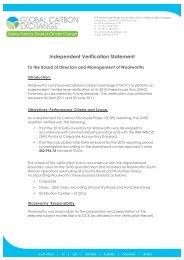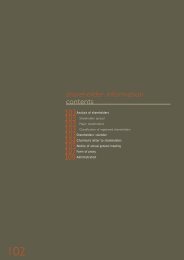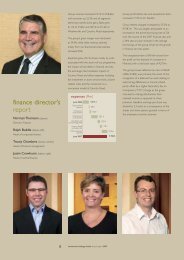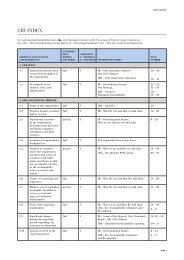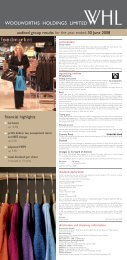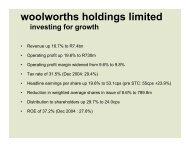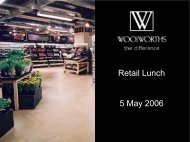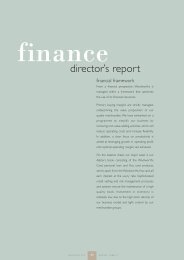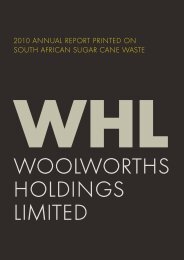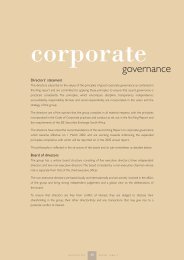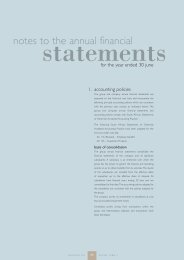WoolWorths holdings limited 2013 good BUsiness JoUrneY report
WoolWorths holdings limited 2013 good BUsiness JoUrneY report
WoolWorths holdings limited 2013 good BUsiness JoUrneY report
Create successful ePaper yourself
Turn your PDF publications into a flip-book with our unique Google optimized e-Paper software.
social<br />
Food Safety<br />
Food safety is critical to the business and<br />
mechanisms are in place to ensure that<br />
consumers are offered product which<br />
has undergone thorough testing and rigid<br />
process control to ensure it is as safe as<br />
possible. Processes include:<br />
• the Woolworths-appointed independent<br />
SANAS- (South African National<br />
Accreditation System) accredited food<br />
laboratory runs routine checks for any<br />
potentially harmful micro-organisms and<br />
pathogens. It also routinely monitors<br />
pesticide residue levels on fresh produce<br />
and heavy metal levels in fresh fish; and<br />
• an independent auditing organisation,<br />
International Britannia Limited (IBL),<br />
conducts four hygiene audits a year<br />
in each of our stores where food is<br />
cooked to ensure that <strong>good</strong> foodhandling<br />
routines are in place.<br />
Woolworths has three standard steps<br />
to prevent our products from potentially<br />
being harmful due to contamination with<br />
microbial pathogens, namely:<br />
• factory hygiene procedures and<br />
processes, e.g. separation of raw and<br />
cooked products (high-/low-risk barriers);<br />
• temperature controls; and<br />
• product date marking.<br />
And to verify the effectiveness of these<br />
controls we:<br />
• do hygiene audits and microbiological<br />
testing;<br />
• do temperature checks all along our<br />
supply chain; and<br />
• audit date controls in stores and verify<br />
product shelf-life through testing.<br />
Food poisoning is caused by specific<br />
pathogenic micro-organisms (or the toxins<br />
produced by these micro-organisms).<br />
Each micro-organism has specific growing<br />
requirements (e.g. water activity, pH,<br />
temperature, etc.).<br />
All factories producing products for<br />
Woolworths are audited independently<br />
by various inspection services and are<br />
visited regularly by the Woolworths<br />
technical team to ensure that the highest<br />
standards are maintained.<br />
As the safety of numerous products<br />
depend on optimal storage temperatures<br />
being maintained, Woolworths takes<br />
great care to maintain a strict cold chain.<br />
The cold chain is the whole process from<br />
producer, via the Woolworths distribution<br />
system and the Woolworths stores, to our<br />
customers. It is essential that the correct<br />
temperature is maintained throughout<br />
this process. If the cold chain is somehow<br />
broken (with temperatures exceeding the<br />
specified range), it drastically shortens the<br />
product life, and temperature-sensitive<br />
products may potentially become harmful<br />
due to the growth of microbial pathogens.<br />
We also date mark products indicating<br />
until when the product can safely be<br />
consumed. Products labelled with a Use By<br />
date, should be consumed on or before<br />
the indicated date. Products labelled with<br />
a Use By date may potentially become<br />
harmful, and therefore should not be<br />
consumed beyond the indicated date,<br />
but destroyed. If products are suitable for<br />
home freezing, they may be frozen prior<br />
to the Use By date, for safe consumption<br />
beyond the Use By date.<br />
Woolworths has a robust product recall<br />
process in place, whereby products<br />
posing a safety risk are removed from the<br />
shelf within two hours of the respective<br />
executive being made aware of the risk.<br />
Woolworths’ labelling policy ensures that<br />
customers are given sufficient accurate<br />
information to allow them to make<br />
informed buying decisions. Woolworths<br />
clothing is fully compliant with government<br />
requirements in terms of labelling which,<br />
in addition to listing the country of origin,<br />
require details of fibre content and care<br />
instructions plus the importer’s code for<br />
imported lines or the manufacturer’s<br />
taxpayer number for local <strong>good</strong>s.<br />
All Woolworths food labels contain<br />
detailed information on ingredients,<br />
nutritional values and allergens.<br />
Food safety is critical<br />
to the business and<br />
mechanisms are in<br />
place to ensure that<br />
consumers are offered<br />
product which has<br />
undergone thorough<br />
testing and rigid<br />
process control to<br />
ensure it is as safe<br />
as possible.<br />
<strong>2013</strong> GOOD BUSINESS JOURNEY / WHL 55



